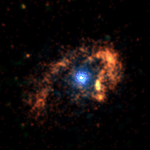October 8, 1999
CXC PR: 99-07
NASA's Chandra X-ray Observatory has imaged Eta Carinae and revealed a hot inner core around this mysterious superstar. The new X-ray observation shows three distinct structures: an outer, horseshoe shaped ring about two light years in diameter, a hot inner core about 3 light months in diameter, and a hot central source less than a light month in diameter which may contain the superstar.
All three structures are thought to represent shock waves produced by matter rushing away from the superstar at supersonic speeds. The temperature of the shock-heated gas ranges from 60 million degrees Celsius in the central regions to 3 million degrees Celsius on the outer structure.
An earlier image of Eta Carinae by the Hubble Space Telescope revealed two spectacular bubbles of gas expanding in opposite directions away from a central bright region at speeds in excess of a million miles per hour. The inner region visible in the Chandra image has never been resolved before, and appears to be associated with a central disk of high velocity gas rushing out at much higher speeds perpendicular to the bipolar optical nebula.
"It is not what I expected," said Dr. Fred Seward of the Harvard-Smithsonian Center for Astrophysics. "I expected to see a strong point source with a little diffuse emission cloud around it. Instead, we see just the opposite– a bright cloud of diffuse emission, and much less radiation from the center."
"The Chandra image contains some puzzles for existing ideas of how a star can produce such hot and intense X-rays," agreed Prof. Kris Davidson of the University of Minnesota. "In the most popular theory, X-rays are made by colliding gas streams from two stars so close together that they'd look like a point source to us. But what happens to gas streams that escape to farther distances? The extended hot stuff in the middle of the new image gives demanding new conditions for any theory to meet."
Eta Carinae is one of the most enigmatic and intriguing objects in our galaxy. Between 1837 and 1856 it increased dramatically in brightness to become the brightest star in the sky except for Sirius, even though it is 7,500 light years away, more than eighty times the distance to Sirius. This "Great Eruption," as it is called, had an energy comparable to a supernova, yet did not destroy the star, which faded to become a dim star, invisible to the naked eye. Since 1940, Eta Carinae has begun to brighten again, becoming visible to the naked eye.
Modern day observations of Eta Carinae have shown it to be the most luminous object known in our galaxy. It radiates at the rate of several million times that of the Sun. Most of the radiation is at infrared wavelengths, from dust in the bipolar nebula. Astronomers still do not know what lies at the heart of Eta Carinae. Most believe that it is powered by an extremely massive star that may be a hundred times as massive as the Sun. Such stars produce intense amounts of radiation that cause violent instabilities before they explode as a supernova.
The Chandra X-ray image gives a glimpse deep into the nebula where the fastest material being thrown off by Eta Carinae is found. The outer ring provides evidence of another large explosion that occurred over a thousand years ago. Further Chandra observations of Eta Carinae are planned for the near future and should give astronomers deeper insight into this cryptic colossus.
To follow Chandra's progress, visit the Chandra site at:
NASA's Marshall Space Flight Center in Huntsville, AL, manages the Chandra program. TRW, Inc., Redondo Beach, CA, is the prime contractor for the spacecraft. The Smithsonian's Chandra X-ray Center controls science and flight operations from Cambridge, MA.
This image will be available on NASA Video File which airs at noon, 3:00 p.m., 6:00 p.m., 9:00 p.m. and midnight Eastern Time. NASA Television is available on GE-2, transponder 9C at 85 degrees West longitude, with vertical polarization. Frequency is on 3880.0 megahertz, with audio on 6.8 megahertz.
High resolution digital versions of the X-ray image (JPG, 300 dpi TIFF) and other information associated with this release are available on the Internet at:
NASA TV on the web
MEDIA CONTACTS
Tim Tyson
Marshall Space Flight Center, Huntsville, AL
Phone: 256-544-0994
Dr. Wallace Tucker
Chandra X-ray Observatory Center
Harvard-Smithsonian Center for Astrophysics, Cambridge, MA
Phone: 617-496-7998
http://chandra.harvard.edu



